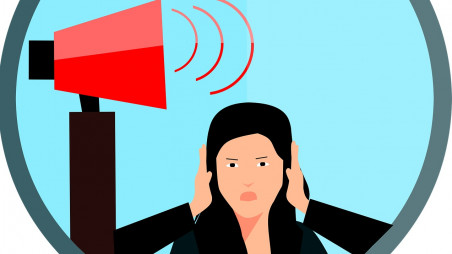Noise pollution rules: A largely ignored law
The negative impacts of noise pollution are causing disruptions to both our health and the environment

A survey conducted by the Department of Environment during 2017 reveals that the majority of the citizens in the country, irrespective of whether they are literate or illiterate, rich or poor, are unaware of sound pollution rules and regulations.
Even though people on a large scale have been suffering from hearing problems caused by noise pollution, a majority of the population know very little about the standard of admissible level of noise and the existing rule that regulates the levels.
And yet there are laws that protect people against sound pollution in the country.
The government of Bangladesh promulgated 'The Noise Pollution (Control) Rules 2006', which attempted to come up with detailed standards on noise pollution and the degree of acceptable noise across the country.
The rules have clustered five types of areas, i.e., silent areas, residential areas, mixed areas, commercial areas, and industrial areas. Then, with a few exceptions, the allowable noise levels were set, which were applicable both during the day and at night.
According to the rules, the listed silent areas include hospitals, educational institutions, offices and similar establishments, and their surrounding 100-meter area. The permitted noise level for residential areas is 55 decibels at day and 45 decibels at night.
In industrial areas, where the highest noise levels are permitted, the limit is 75 decibels at day and 70 decibels at night. In the explanation of the rules, it has been mentioned that hours between 6 am and 9 pm is considered as daytime while the remaining hours are considered as night-time.
Under 'Schedule-2', a distinct range has been established for vehicular noise, and the use of horns is forbidden in places designated as silent areas.
However, if permission is obtained three days before the event, the sound level can be surpassed for social, cultural, and political events such as weddings, sports, concerts, fairs, and bazaars held in open or semi-open places.
The Rule also states that no construction machines used for processing and breaking down building materials (bricks, stones, etc.) shall be used within 500 meters of any residential areas.
Noise abatement law and policy can only be established and implemented successfully if basic knowledge and background material are available to the masses, including the authorities/administration
Provisions have been referred to the rules that any person can contact the concerned authorities with any complaints regarding contravention of the Rule either verbally or over the phone or in writing. It states that officials empowered under the 1995 Environment Conservation Act can, in pursuance of the Rule, enter an establishment and confiscate any noise-producing instrument.
Exemptions have been made for religious activities held in mosques or temples, as well as activities commemorating key national holidays such as Independence Day, Bengali New Year, and International Mother Language Day.
Scientific studies show that noise pollution above 120 decibels may cause many adverse biochemical changes. Continued exposure to high levels of noise results in fatigue, changes in blood circulation, hypertension and changes in breathing, hearing loss or even total loss of hearing.
WHO data shows that nearly 5% of the global population has been suffering from noise pollution. According to a 2017 research by the Department of Environment (DoE), sound levels in every divisional city in Bangladesh have exceeded permissible limits, with noise levels in certain places being twice or triple of what's allowed.
The study also revealed that around 11.7% of the population of Bangladesh has lost their hearing due to noise pollution. WHO has termed noise pollution as an underestimated threat that can cause hearing loss, cardiovascular problems, cognitive impairment, stress, and depression etc. In managing noise pollution WHO recommended three principles, i.e., precautionary principle, polluter pays principle, prevention principle.
Although noise and its management are not identified in any of the 17 goals of the Sustainable Development Goals (SDGs), noise is an issue cross-cutting through almost all of the goals. Through the lens of the SDGs, there are scientific pieces of evidence showing how a failure to address sound pollution presents a significant challenge to the realisation of these goals.
Noise abatement law and policy can only be established and implemented successfully if basic knowledge and background material are available to the masses, including the authorities/administration. It is, therefore, necessary to include noise in school curricula and to establish scientific institutes to study acoustics and noise control. Dissemination of noise control information to the mass people is an issue for education and public awareness.
Ideally, national and local advisory and vigilant groups should be formed to promote the dissemination of information, establish uniform methods of noise measurement and impact assessment, and participate in the development and implementation of educational and public awareness programmes.
Sadrul Hasan Mazumder is a policy activist. Email: m.sadrul@hotmail.com.
Disclaimer: The views and opinions expressed in this article are those of the authors and do not necessarily reflect the opinions and views of The Business Standard



 Keep updated, follow The Business Standard's Google news channel
Keep updated, follow The Business Standard's Google news channel
















